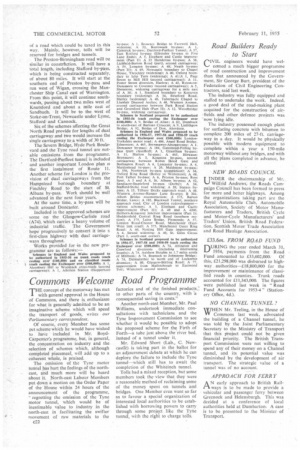Road Builders Ready to Start
Page 62

If you've noticed an error in this article please click here to report it so we can fix it.
CIVIL engineers would have welcomed a much bigger programme of road construction and improvement than that announced by the Government, Sir George Burt, president of the Federation of Civil Engineering Contractors, said last week.
The industry was fully equipped and staffed to undertake the work. Indeed, a good deal of the road-making plant acquired for the construction of airfields and other defence projects was now lying idle.
The industry possessed enough plant for surfacing concrete with bitumen to complete 200 miles of 27-ft carriageway in a day. It would be physically possible with modern equipment to complete within a year a 150-mile motorway without any bridges, and with all the plans completed in advance, he stated.
NEW ROADS COUNCIL
1NDER the chairmanship of Mr.
Wilfrid Andrews, the Roads Campaign Council has been formed to press for more and better highways. Among the organizations taking part are the Royal Automobile Club, Automobile Association, Society of Motor Manufacturers and Traders, British Cycle and Motor-Cycle Manufacturers' and Traders' Union, British Road Federation, Scottish Motor Trade Association and Road Haulage Association.
03.6m, FROM ROAD FUND riURING the year ended March 31, Li 1954, payments from the Road
Fund amounted to £33,602,000. Of this, £21,298,000 was disbursed to highway authorities-118,800,000 for the improvement or maintenance of classified roads in counties. Trunk roads accounted for £11,343,000. The figures were published last week in "Road Fund Accounts for 1953-4" (Stationery Office, 4d.).
NO CHANNEL TUNNEL?
WHEN Mr. Teeling, in the House of VT Commons last week, advocated the building of a Channel tunnel, he was told by the Joint Parliamentary Secretary to the Ministry of Transport that this froject could not be given financial priority. The British Transport Commission were not willing to spend any of their money on a Channel tunnel, and its potential value was diminished by the development of air transport. The strategic value of a tunnel was of no account.
APPROACH FOR FERRY .1-1 A N early approach to British Rail
ways is to be made to provide a vehicular and passenger ferry between Creenock and Helensburgh. This was decided at a conference of local authorities held at Dumbarton; A ease is to be presented to the Minister of Transport.
















































































































